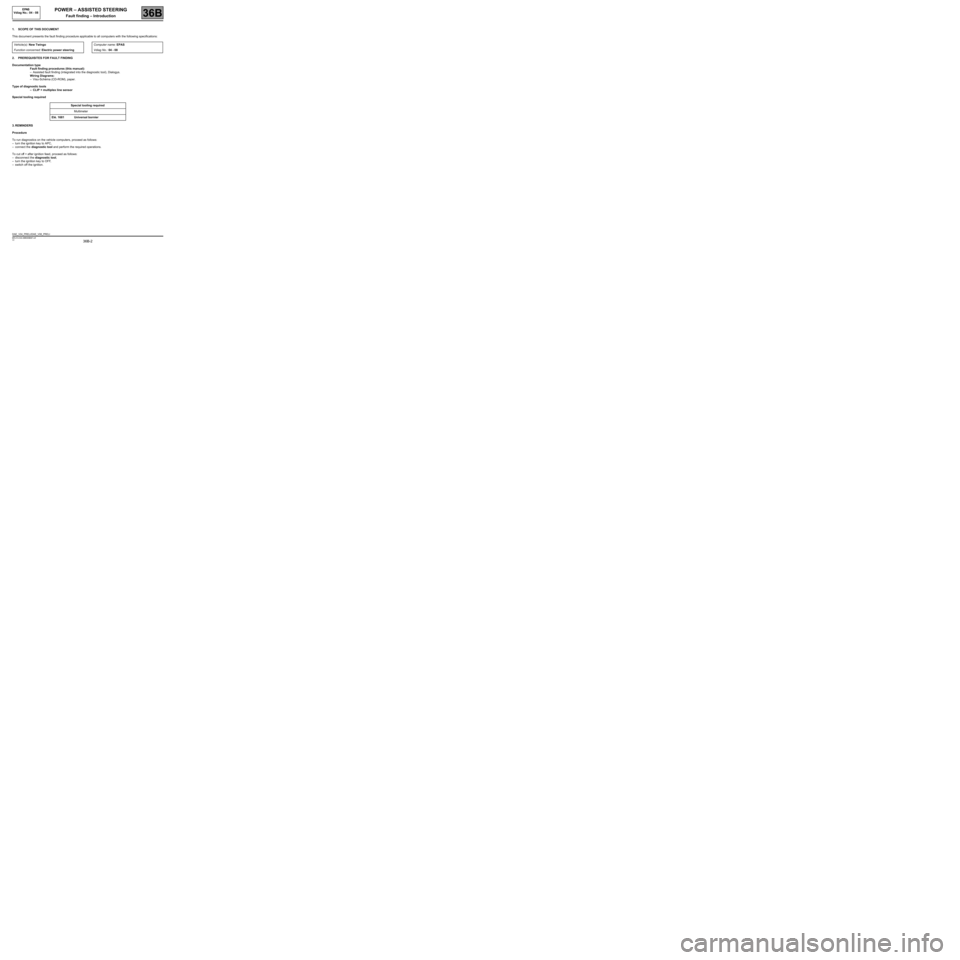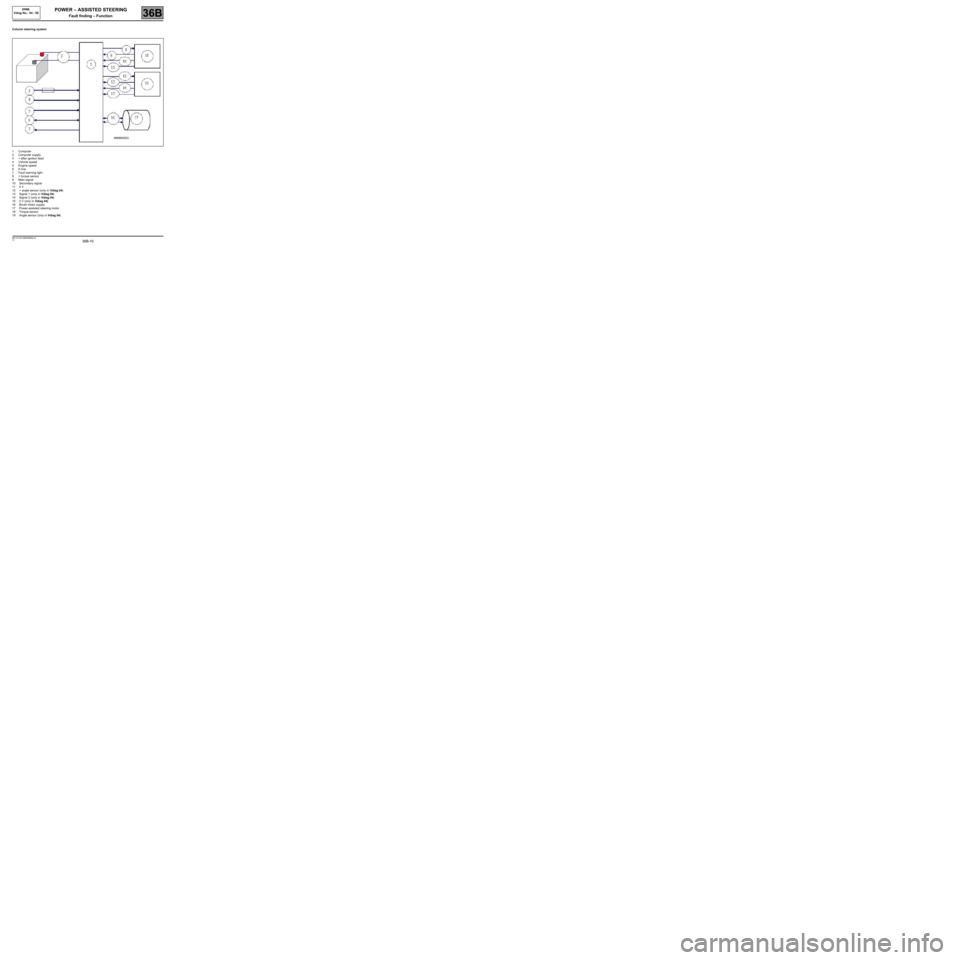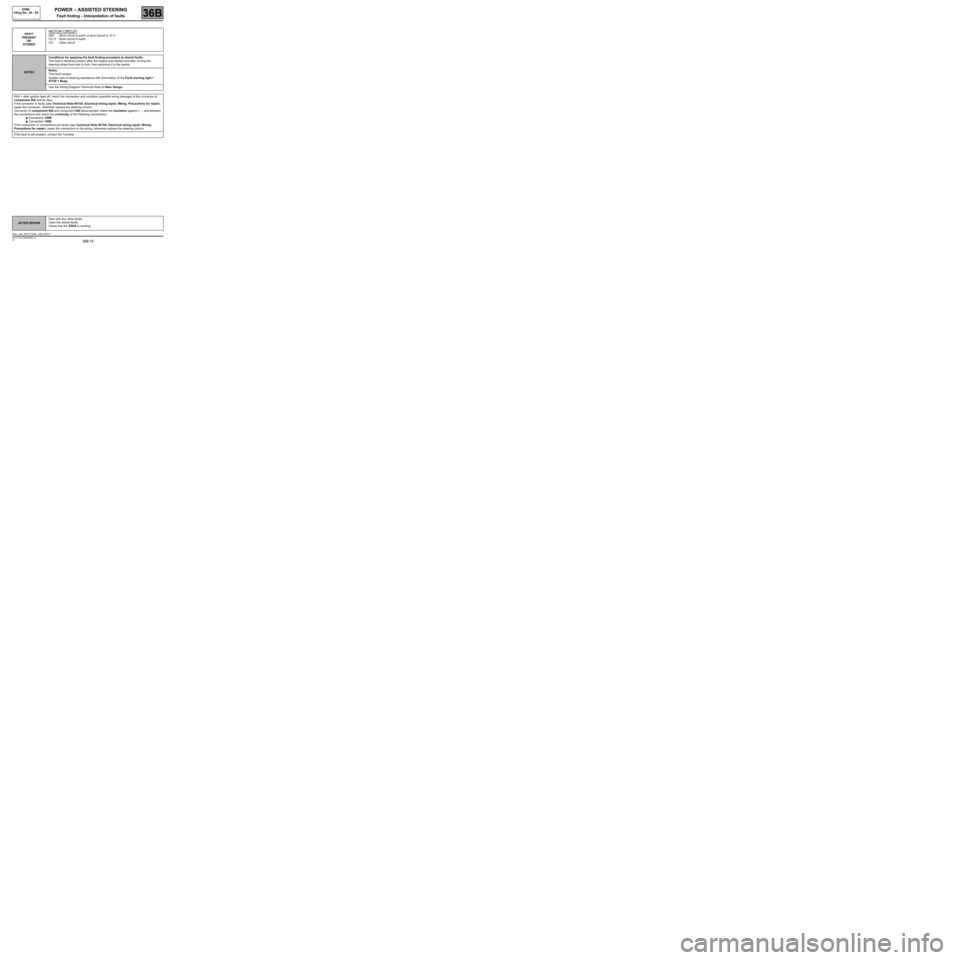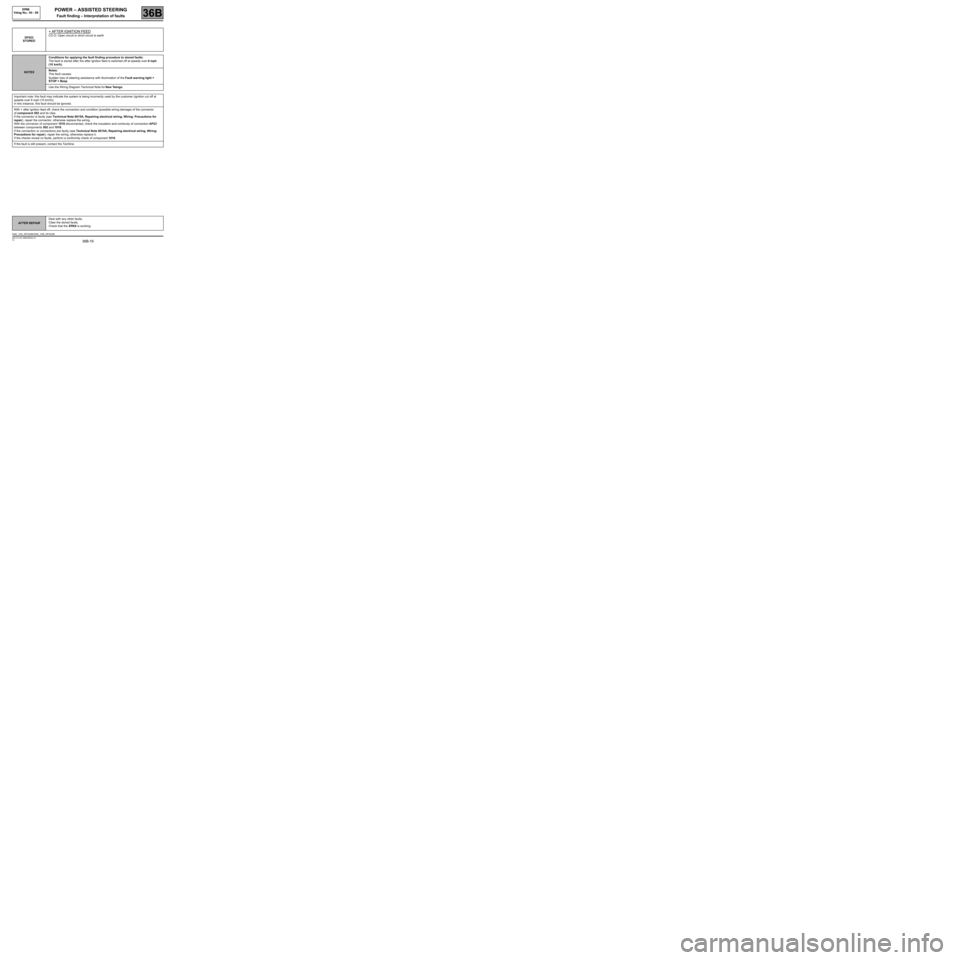ignition RENAULT TWINGO 2009 2.G Chasiss - Power Assisted Steering Workshop Manual
[x] Cancel search | Manufacturer: RENAULT, Model Year: 2009, Model line: TWINGO, Model: RENAULT TWINGO 2009 2.GPages: 54
Page 2 of 54

36B-2
MR-413-X44-36B000$067.mif
V2
36B
POWER – ASSISTED STEERING
Fault finding – Introduction
1. SCOPE OF THIS DOCUMENT
This document presents the fault finding procedure applicable to all computers with the following specifications:
2. PREREQUISITES FOR FAULT FINDING
Documentation type
Fault finding procedures (this manual):
–Assisted fault finding (integrated into the diagnostic tool), Dialogys.
Wiring Diagrams:
–Visu-Schéma (CD-ROM), paper.
Type of diagnostic tools
–CLIP + multiplex line sensor
Special tooling required
3. REMINDERS
Procedure
To run diagnostics on the vehicle computers, proceed as follows:
–turn the ignition key to APC,
–connect the diagnostic tool and perform the required operations.
To cut off + after ignition feed, proceed as follows:
–disconnect the diagnostic tool,
–turn the ignition key to OFF,
–switch off the ignition. Vehicle(s): New Twingo
Function concerned: Electric power steeringComputer name: EPAS
Vdiag No.: 04 - 08
Special tooling required
Multimeter
Elé. 1681 Universal bornier
DAE_V04_PRELI/DAE_V08_PRELI
EPAS
Vdiag No.: 04 - 08
MR-413-X44-36B000$067.mif
Page 3 of 54

36B-3
MR-413-X44-36B000$067.mif
V2
POWER – ASSISTED STEERING
Fault finding – Introduction
EPAS
Vdiag No.: 04 - 08
36B
Faults
Faults are declared present or stored (depending on whether they appeared in a certain context and have
disappeared since, or whether they remain present but are not diagnosed within the current context).
The present or stored status of faults should be taken into consideration when the diagnostic tool is switched on
after the + after ignition feed (without any system components being active).
For a present fault, apply the procedure described in the Interpretation of faults section.
For a stored fault, note the faults displayed and apply the instructions in the Notes section.
If the fault is confirmed when the instructions in the Notes section are applied, the fault is present. Deal with
the fault.
If the fault is not confirmed, check:
–the electrical lines which correspond to the fault,
–the connectors on these lines (corrosion, bent pins, etc.),
–the resistance of the component detected as defective,
–the condition of the wires (melted or split insulation, wear).
Conformity check
The aim of the conformity check is to check data that does not produce a fault on the diagnostic tool because the
data is inconsistent. Therefore, this stage is used to:
–carry out fault finding on faults that do not have a fault display, and which may correspond to a customer
complaint.
–check that the system is operating correctly and that there is no risk of a fault recurring after repairs.
This section gives the fault finding procedures for statuses and parameters and the conditions for checking them.
If a status is not behaving normally or a parameter is outside the permitted tolerance values, consult the
corresponding fault finding page.
Customer complaints - Fault finding chart
If the test with the diagnostic tool is OK but the customer complaint is still present, the fault should be processed by
customer complaints.
A summary of the overall procedure to follow is provided on the following page in
the form of a flow chart.
Page 10 of 54

36B-10
MR-413-X44-36B000$268.mif
V2
36B
POWER – ASSISTED STEERING
Fault finding – Function
Column steering system
1Computer
2Computer supply
3+ after ignition feed
4Vehicle speed
5Engine speed
6K line
7Fault warning light
8+ torque sensor
9Main signal
10 Secondary signal
11 0 V
12 + angle sensor (only in Vdiag 04)
13 Signal 1 (only in Vdiag 04)
14 Signal 2 (only in Vdiag 04)
15 0 V (only in Vdiag 04)
16 Brush motor supply
17 Power-assisted steering motor
18 Torque sensor
19 Angle sensor (only in Vdiag 04)
EPAS
Vdiag No.: 04 - 08
MR-413-X44-36B000$268.mif
Page 11 of 54

36B-11
MR-413-X44-36B000$268.mif
V2
POWER – ASSISTED STEERING
Fault finding – Function
EPAS
Vdiag No.: 04 - 08
36B
GENERAL OPERATION
On this vehicle, the steering system is power-assisted by an electric motor attached to the steering column.
The torque sensor and steering column angle sensor interpret any movement of the steering wheel as it is turned.
Assistance is provided by an electric motor which applies more or less torque to the steering column, in one direction
or the other.
A computer controls this assistance according to several vehicle environment parameters, including the vehicle
speed.
EPAS ALSO OFFERS THE FOLLOWING:
Active recall:
This function is made necessary by the design of the front axle of vehicles with electric power-assisted steering.
It returns the steering wheel to the centre point when driving at low speeds (5 to 20 mph / 8 to 32 km/h) but not when
the vehicle is stationary. This function is normal on hydraulic power-assisted steering vehicles or vehicles without
assistance.
This function cannot be deactivated by the diagnostic tool.
Depending on the operating conditions and the operations performed on the vehicle before switching on the ignition,
the assistance system may take a certain amount of time to be activated after engine starting, for instance after
battery cut-off or switching off the ignition (see Configurations and programming).Note:
When the computer detects a fault, the level of assistance can be modified depending on how serious the fault is.
An incorrect or absent vehicle speed signal results in assistance equal to that provided at 72 mph (120 km/h)
without active return. The EPAS sends a "Steering wheel angle signal" to the ABS/ESP computer.
Page 12 of 54

36B-12
MR-413-X44-36B000$268.mif
V2
POWER – ASSISTED STEERING
Fault finding – Function
EPAS
Vdiag No.: 04 - 08
36B
SIGNALS RECEIVED AND SENT
1Vehicle speed
2Engine speed
3Power supply (permanent +)
4Supply (+ after ignition feed)
5Earth
6Steering wheel angle (Vdiag 04 only)
7Steering wheel torque
8Instrument panel indicator light on
9Diagnostic socket
10 Power-assisted steering computer
Page 13 of 54

36B-13
MR-413-X44-36B000$335.mif
V2
36B
POWER – ASSISTED STEERING
Fault finding – Replacement of components
Precautions for use
–The electric motor and upper column (EPAS system) assembly cannot be taken apart.
–Only reuse an EPAS system from one vehicle on another vehicle if the column and computer part numbers match.
A. Replacing the EPAS (computer - top steering column assembly):
Before replacing the EPAS, run fault finding on the system: apply the appropriate fault finding procedure.
The EPAS may be replaced only with the consent of the Techline.
When replacing the electric power assisted steering, carry out the following operations in order:
–disconnect the vehicle battery,
–replace the EPAS (see MR411 Mechanical systems, 36B, Power-assisted steering),
–reconnect the vehicle battery,
–connect the diagnostic tool, switch on the ignition and establish dialogue with the electric power-assisted
steering computer (EPAS computer),
–perform the configurations (see Configurations and programming),
–check that there are no faults, check the conformity of the variables, and check that the EPAS operates correctly
(steering assistance provided when the engine is running),
–perform a road test then, without switching off the ignition, check that status ET020 Steering wheel angle
sensor programming is Programmed (only for Vdiag 04).
B. Replacing the intermediate shaft or the steering rack (without changing the EPAS):
–disconnect the vehicle battery,
–replace the intermediate shaft or the steering rack (see MR 411 Mechanical systems, 36A, Steering
assembly),
–reconnect the vehicle battery,
–connect the diagnostic tool, switch on the ignition and establish dialogue with the electric power-assisted
steering computer (EPAS computer),
–check that there are no faults,
–check that the EPAS is working correctly (steering assistance available when the engine is running).
C. Replacing the power-assisted steering computer:
–disconnect the vehicle battery,
–replace the power-assisted steering computer,
–reconnect the vehicle battery,
–connect the diagnostic tool, switch on the ignition and establish dialogue with the electric power-assisted
steering computer (EPAS computer),
–configure the computer (see Configurations and programming),
–check that there are no faults,
–check that the EPAS is working correctly (steering assistance available when the engine is running). WARNING
Never leave the ignition switched on or the engine running during a mechanical operation on the EPAS or the
front axle. To avoid any accident, the battery must be disconnected (to prevent the risk of accidentally triggering
the EPAS motor).
EPAS
Vdiag No.: 04 - 08
MR-413-X44-36B000$335.mif
Page 14 of 54

36B-14
MR-413-X44-36B000$402.mif
V2
36B
POWER – ASSISTED STEERING
Fault finding – Configurations and programming
Summary table of configurations and configuration readings
CONFIGURATION:
After replacing the EPAS computer, configure the computer using command CF073 Strategy number.
The following procedure must be followed for this configuration:
–connect the diagnostic tool,
–switch on the ignition and establish dialogue with the electric power-assisted steering computer,
–Clear the faults using command RZ001 Fault memory.
–select the Repair mode menu,
–use command CF073 Strategy number to perform the configuration and select the relevant strategy number
using the table as a guide,
–make sure the configuration readings have been properly registered,
–check that the system is operating correctly (steering assistance available when the engine is running).
STEERING WHEEL ANGLE PROGRAMMING:Configuration Configuration readings
CF073Strategy numberLC002Strategy number
LC001Type of power-assisted steering
IMPORTANT
The steering wheel angle sensor is programmed automatically each time the vehicle is driven and therefore it
cannot be programmed using the tool.
EPAS
Vdiag No.: 04 - 08
MR-413-X44-36B000$402.mif
Page 15 of 54

36B-15
MR-413-X44-36B000$469.mif
V2
36B
POWER – ASSISTED STEERING
Fault finding – Fault summary table
Tool fault Diagnostic tool titleAssociated
DTCCustomer complaints and warning
light coming on
DF001Motor thermal protection5660Steering assistance intermittent
reduction (no warning light or buzzer)
DF002Computer5640No assistance on start-up or sudden
loss of assistance with EPAS fault
warning light, STOP warning light and
buzzer
DF017Motor circuit5630Sudden loss of assistance with EPAS
fault warning light, STOP warning light
and buzzer
DF023+ after ignition feed5622Gradual loss of assistance with EPAS
fault warning light, STOP warning light
and buzzer
DF028Engine speed zero5621Incorrect level of assistance (no warning
light or buzzer)
DF037Battery voltage5650Sudden loss of assistance with EPAS
fault warning light, STOP warning light
and buzzer
DF038Angle sensor5610Loss of "active return" function with no
warning light
DF039Torque sensor circuit5603Sudden loss of assistance with EPAS
fault warning light, STOP warning light
and buzzer
DF043Vehicle speed5620Incorrect level of assistance (no warning
light or buzzer)
DF048Torque sensor circuit5602Sudden loss of assistance with EPAS
fault warning light, STOP warning light
and buzzer
DF050Torque sensor circuit signal 25601Sudden loss of assistance with EPAS
fault warning light, STOP warning light
and buzzer
DF054Torque sensor5600Sudden loss of assistance with EPAS
fault warning light, STOP warning light
and buzzer
EPAS
Vdiag No.: 04 - 08
MR-413-X44-36B000$469.mif
Page 18 of 54

36B-18
MR-413-X44-36B000$469.mif
V2
POWER – ASSISTED STEERING
Fault finding – Interpretation of faults
EPAS
Vdiag No.: 04 - 08
36B
DF017
PRESENT
OR
STOREDMOTOR CIRCUIT
DEF : Short circuit to earth or short circuit to 12 V
CC.O : Short circuit to earth
CO : Open circuit
NOTESConditions for applying the fault finding procedure to stored faults:
The fault is declared present after the engine was started and after turning the
steering wheel from lock to lock, then returning it to the centre.
Notes:
This fault causes:
Sudden loss of steering assistance with illumination of the Fault warning light +
STOP + Beep.
Use the Wiring Diagram Technical Note for New Twingo.
With + after ignition feed off, check the connection and condition (possible wiring damage) of the connector of
component 502 and its clips.
If the connector is faulty (see Technical Note 6015A, Electrical wiring repair, Wiring: Precautions for repair),
repair the connector, otherwise replace the steering column.
Connector of component 502 and component 540 disconnected: check the insulation against +, -, and between
the connections and check the continuity of the following connections:
●Connection 109R
●Connection 109S
If the connection or connections are faulty (see Technical Note 6015A, Electrical wiring repair, Wiring:
Precautions for repair), repair the connectors or the wiring, otherwise replace the steering column.
If the fault is still present, contact the Techline.
AFTER REPAIRDeal with any other faults.
Clear the stored faults.
Check that the EPAS is working.
DAE_V04_DF017 /DAE_V08_DF017
Page 19 of 54

36B-19
MR-413-X44-36B000$469.mif
V2
POWER – ASSISTED STEERING
Fault finding – Interpretation of faults
EPAS
Vdiag No.: 04 - 08
36B
DF023
STORED
+ AFTER IGNITION FEED
CO.O: Open circuit or short circuit to earth
NOTESConditions for applying the fault finding procedure to stored faults:
The fault is stored after the after ignition feed is switched off at speeds over 6 mph
(10 km/h).
Notes:
This fault causes:
Sudden loss of steering assistance with illumination of the Fault warning light +
STOP + Beep.
Use the Wiring Diagram Technical Note for New Twingo.
Important note: this fault may indicate the system is being incorrectly used by the customer (ignition cut off at
speeds over 6 mph (10 km/h)).
In this instance, this fault should be ignored.
With + after ignition feed off, check the connection and condition (possible wiring damage) of the connector
of component 502 and its clips.
If the connector is faulty (see Technical Note 6015A, Repairing electrical wiring, Wiring: Precautions for
repair), repair the connector, otherwise replace the wiring.
With the connector of component 1016 disconnected, check the insulation and continuity of connection AP23
between components 502 and 1016.
If the connection or connections are faulty (see Technical Note 6015A, Repairing electrical wiring, Wiring:
Precautions for repair), repair the wiring, otherwise replace it.
If the checks reveal no faults, perform a conformity check of component 1016.
If the fault is still present, contact the Techline.
AFTER REPAIRDeal with any other faults.
Clear the stored faults.
Check that the EPAS is working.
DAE_V04_DF023M/ DAE_V08_DF023M